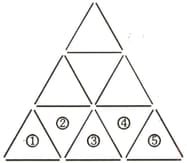Arithmetic Progression
Arithmetic Progression: Overview
This topic covers concepts such as Arithmetic Progression (A.P.), Common Difference of an A.P., nth Term of an A.P., Sum of First n Terms of an A.P, Properties of A.P., Arithmetic Mean (A.M.) of Two Numbers, Mean, etc.
Important Questions on Arithmetic Progression
For what value of , is the arithmatic mean of and .
For each positive integer , let denote the increasing arithmetic sequence of integers whose first term is and whose common difference is . For example, is the sequence . Find the number of values of for which contain the term .
If are positive and are in and roots of the quadratic equation are real then
In an , the first term is and the sum of the first terms is zero. What is the sum of next terms?
The first and the second terms of an are and respectively. If term is the largest negative term, what is the value of ?
and are in such that and . What is the difference between largest and smallest numbers?
A large equilateral triangle is constructed by using toothpicks to create rows of small equilateral triangles. For example, in the figure we have rows of small congruent equilateral triangles, with small triangles in the base row. Total number of toothpicks would be needed to construct a large equilateral triangle if the base row of the triangle consists of small equilateral triangles. Then find the sum of all digits of

A circle with area is contained in the interior of a larger circle with area . If the radius of the larger circle is , and if is an arithmetic progression, then the radius of the smaller circle is
and are three consecutive terms of an for
The sum of 's between two distinct real numbers is . Then the single A.M. between those two numbers is
If the term of an A.P. is , the last term is and the sum of the terms is , then its common difference is
If are in A.P. with common difference d, then
If the term of an A.P. is and the common difference is , then its term is
are three A.P.'s such that the first term of both and is ; and and bear the same common difference. Moreover, the term of is same as the term of . If the term of differs numerically from term of by , then the term of is
If is divided into parts which are in A.P., in such a way that the product of extremes is to the product of two middle parts is , then the third part is
The term of an A.P. is same as the term of another A.P. If the two A.P.s have the same first term, then
The first term of each of two finite A.P.'s with same number of terms is and their last terms are respectively and . Then
If the term of an arithmetic progression is , then the common difference of tin progression is
If are in A.P., then the value of is
If and terms of an A.P. are respectively and ,then the term of the A.P. is
